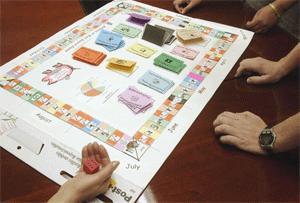Balance or Bust Board Game
This page provides links to downloadable documents that local agencies can use to develop their own version of the Balance or Bust game developed by the City of Cupertino.
To play the game, you will need:
- Game board (Cupertino glued theirs to a 20 x 30 foam board)
- Die; Cupertino bought one for $.50 at a game shop
- Play piece; Cupertino used a city lapel pin or a chocolate kiss
- Game cards that detail potential cuts, grant opportunities, unexpected news, etc.
The templates on posted under Documents & Resources at right:
- Game board (PDF)
- Game card for challenge side of the cards (MS Word)
- Game card face to place logo/clip art (MS Word)
- Complete list of challenges, by division (MS Word)
- Complete game instructions (MS Word)
- Instructions, sample documents and clip art (PPT)
Cupertino’s cards were printed out on color paper that matched the corresponding squares on the board and the pie chart (logo on one side, challenge on the other side), cut, and folded in half. Instead, you may want to use Avery business card paper stock, #AVE-5882, AVE-5871, or AVE-08871, which is a 2” x 3½” size.
Please read the instructions first as they will help you determine how to best customize the game for your use.
Instructions
OBJECTIVE: Your “City Council Team” must decrease spending (or increase revenue) by $2,000,000 by the end of the fiscal year (one trip around the board equals one fiscal year). The Fiscal Year is July 1 to June 30. December 31 is “Midyear” and the Council considers midyear budget adjustments in January
Team members consecutively roll the die and draw cards. Each card describes a service that can be cut or reduced, and the amount of savings.
- If you make the cut before mid-year (January), you save the whole amount. After midyear, the amount you save is reduced by half.
- If the Team does not want to cut the whole amount, the team may decide to modify the amount of the cut and accept a lower quality of service.
TO BEGIN:
- Select a “Mayor” and a “City Clerk”.
- The “Mayor” will facilitate the workings of the Council Team and will report on its actions at the end of the game.
- The “Mayor” rolls the die last. The person to the left of the Mayor rolls first and the players roll in turn, clockwise, around the table.
- The “City Clerk” will record the team’s actions on the City Clerk Ledger Sheet and track the cards as: cuts, potential cuts, and do not cut.
There are other special squares:
DARK PINK squares are for a Grant Opportunity. If you land on the dark pink (Grant Application) square, you get a second roll. If on your second roll you land on the other dark pink square (Grant Awarded), you are successful and can use the money for the specific project you applied to fund. If you land on the Grant Awarded square only (without landing on the Grant Application first, you do not get the money because you didn’t apply!
DARK GREEN squares are Economic Development opportunities. Like grants, new developments are tenuous propositions. If you land on a dark green square, you get a second roll. Some new revenue may come your way, but only if you successfully avoid the take-away square ($) on your second roll. Your “City Clerk” will be listing all the cards drawn, including all new revenues that come your way.
BLACK squares are bad news of the economic sort, and include: earthquakes, economic downturns, state take-aways and lawsuits. Your team may choose to dip into your $1,000,000 emergency reserve “piggy bank” if you draw a black card. After you have used up the reserve, the impacts will affect your bottom line.
NOW IT’S JANUARY AND TIME FOR THE – MID-YEAR BUDGET ADJUSTMENT:
When your team reaches “midyear”, your team “Mayor” will:
- Call time and stop the game to take stock
- Review what you have listed on your ledger sheet
- Evaluate your progress toward reaching the $2,000,000 budget reduction by the end of the year. How have you done? How much of what you have drawn will you actually cut? What will the impacts be? Can you charge new fees?
Many cards are marked with a midyear amount, which should be used
if your team chooses to cut that service in January of your
fiscal year.
You still have 6 months to go. Remember that all the cuts you
make now, at mid-year, are for half the amount shown on the card.
POT O’GOLD – If you are lucky, you may hit the “Pot O’Gold” square in the second half of the year, which will solve many of your economic problems, but the odds are against it.
AT THE END OF THE FISCAL YEAR
- The team Mayor will ask the City Clerk for the record. Has your team balanced the budget?
- Your team Mayor will ask the group:
- What cuts did you make?
- What cuts were the easiest or hardest to make?
- How did the Team Council prioritize its spending?
- What criteria did you use to make cuts?
- What core values did your Council Team feel were important to the overall community?
- What was the single most important thing you learned from this exercise?
- After the break, your team Mayor will report to the Community Congress on your answers to these questions.
If your team is unable to complete the task in the time allotted, the city’s bond rating slips and the city is at risk for bankruptcy.





